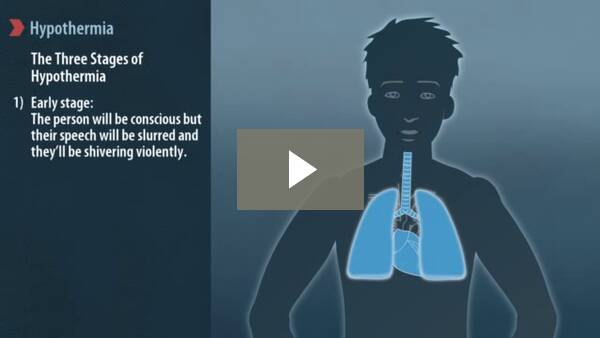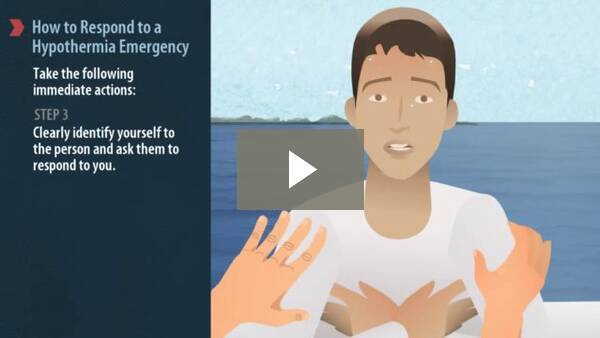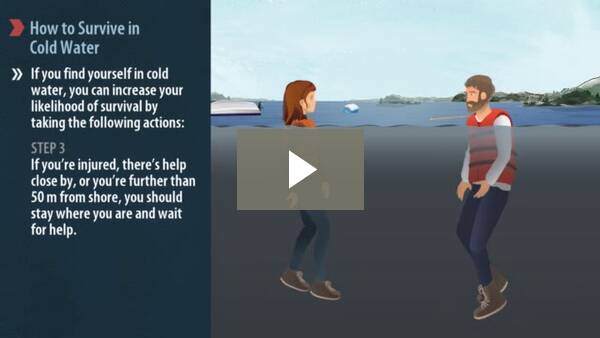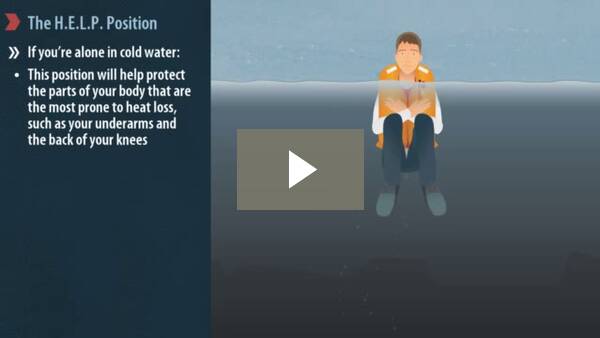Cold Water Immersion and Hypothermia
Capsizing and person overboard emergencies are incredibly dangerous situations. Add cold air and/or cold water temperatures to the equation and the the level of danger increases dramatically. Performing a quick rescue is the MOST important thing to remember if one of your passengers falls into cold water. Why? Because their body will lose heat 25 times faster than it would if it were only exposed to cold air, making them unlikely to be unable to assist with their own rescue. Responding quickly will be especially important if the person overboard is struggling in the water (as most do) because the physical exertion will cause their body to lose heat 35 times faster.
The Impact of Cold Water Immersion on Your Body
Cold water immersion occurs when a person experiences sudden, unexpected immersion into water 15°F or below. If this happens to one of your passengers, their body will experience the following four phases of physiological impact:
- Initial reaction (cold shock): This phase lasts for about one minute. A deep and sudden gasp will be followed by hyperventilation and involuntary gasping. These actions can cause the person to inhale water and drown. During this time, the person overboard must avoid panicking and concentrate on controlling their breathing. Wearing a life jacket at this initial phase will be critical to their survival.
- Short-term immersion (swimming failure): This phase lasts for about 10 minutes. During this time, the person overboard will lose the use of their fingers, arms and legs. Swim failure will occur within these critical minutes and if the person overboard is not wearing a life jacket, they will likely drown.
- Long-term immersion (hypothermia): The next phase is when hypothermia sets in. It can take up to an hour before the person will become unconscious. During this time, the body organs will be cooling and the internal temperature of the body will be dropping. Following the phase of unconsciousness, if not rescued and treated immediately, the person overboard will likely die.
- Post-rescue collapse: Once rescued, the person will experience a phase during which their body is under extreme stress and at risk of cardiac arrest. The arterial blood pressure will change and the cold blood from their limbs will re-enter the internal body core, causing dangerous stress on their heart and the brain.
Note: Always wear your life jacket and properly secure it—especially if you’re boating in cold weather or in cold water areas. If a life jacket is thrown to you once you’re already in the water, your muscles may already be paralyzed from the cold and you may be unable to secure the life jacket you’re wearing or to reach for a flotation device that is thrown to you.
Hypothermia
Hypothermia is caused by prolonged exposure to abnormally low temperatures or prolonged exposure to dampness. It sets in when the internal body temperature drops to 95° (F) or lower.
Boaters can become hypothermic through:
- Immersion in cold water.
- Exposure to cold air and wind while wearing damp or wet clothing.
- Prolonged exposure to cold water and air temperatures.
The Three Stages of Hypothermia:
- Early stage: The person will be conscious but their speech will be slurred and they’ll be shivering violently.
- Intermediate stage: Although still conscious, the person will be irrational, confused and sleepy. Their pulse and breathing will be weak, their muscle functions will be reduced and their movements will be uncoordinated.
- Final stage: The person will begin to collapse and lose consciousness. Their pulse and breathing will be very weak and irregular at this stage.
How to Respond to a Hypothermia Emergency:
Take the following immediate actions:
Step 1) Ensure that you’re wearing a Coast Guard- approved life jacket before you begin the rescue.
Step 2) Assess the person’s current condition: What stage of hypothermia have they reached?
Step 3) Clearly identify yourself to the person and ask them to respond to you.
Step 4) Assess your ability to help the person: Do you have warm, dry items on the boat that you can use to cover and warm them with? Will you be able to get them to shore quickly for medical help?
Step 5) If necessary, exhibit a distress signal indicate your distress.
Perform the following rescue procedure:
Step 1) Remove the person from the water and provide dry shelter (you should use the overboard rescue techniques, previously described in order, to recover the person from the water).
Step 2) Dry them off from head to toe and dress them with layers of dry clothing. Provide dry shelter below deck, if possible.
Step 3) Attempt to slowly increase the person’s core body temperature by doing the following:
- Cover their head and neck with warm blankets.
- Wrap their body in dry blankets or towels.
- Cover them with an insulating device (such as a reflective heat blanket) and moisture barrier.
Remember:
- If the person asks you for a warm liquid, they can have it—but NEVER give them a drink that has alcohol or caffeine in it.
- Do not rub or massage their body or limbs in an attempt to warm them up—doing this may damage nerve endings at the skin and encourage cold blood from the limbs to move to the core of their body.
- You can use your own body to transfer heat to the victim.
- You should always carry a safety kit, including equipment suitable for cold water and cold weather emergencies.
Safe Boating Tip:
Remember that the water temperature does not need to be very cold for hypothermia to set in and take effect on a person’s body. In fact, under certain conditions, even prolonged exposure to dampness on a rainy day can put you at risk of hypothermia.
How to Survive in Cold Water:
If you find yourself in cold water, you can increase your likelihood of survival by taking the following actions:
Step 1) Assess the situation:
- Is everyone wearing a Coast Guard-approved life jacket?
- Can you get to shore or to a safe location?
- Are there any boaters nearby who can assist you?
- Are you able to signal or call for help?
Step 2) If you’re within 50 m of shore and are able to swim to safety, you should do so.
Step 3) If you’re injured, there’s help close by, or you’re further than 50 m from shore, you should stay where you are and wait for help.
Step 4) If you’re alone and close to a floating object, you should climb onto the object to remove yourself from the cold water and to save your energy. However, only do so if you’re able to get most of your body out of and above the water.
Step 5) Immediately signal or call for help.
Safe Boating Tip:
Remember, a whistle would be a great tool to have attached to your life jacket in an overboard emergency! You’ll need to get out of cold water quickly and blasting a whistle will help get you the attention you’ll need!
The ‘H.E.L.P.’ and ‘Huddle’ Positions
The best way to survive cold water is to get out of it as quickly as possible. However, if this isn’t an option, you must conserve your body heat to increase your survival time. You can do this by assuming one of the following two positions:
The H.E.L.P. Position
If you’re alone in cold water:
- Pull your knees towards your chin and cross your arms tightly across your chest.
- This position will help protect the parts of your body that are the most prone to heat loss, such as your underarms and the back of your knees.
The Huddle Position
If you’re in cold water with other people:
- Place your arms around each other’s mid to lower back and pull together so that your chests are close to each other’s sides.
- Intertwine your legs.
- Place any children in the middle of the huddle.
- Keep unnecessary movements to a minimum in order to conserve energy.















